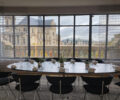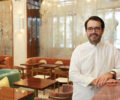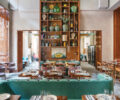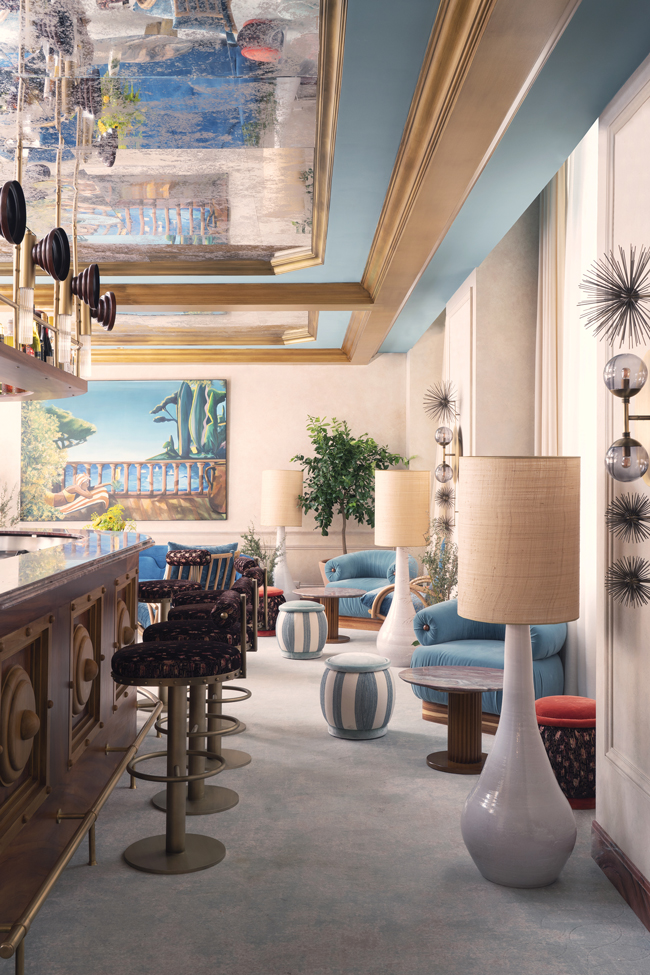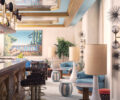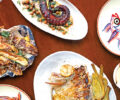Exciting New Museum Restaurants in Paris
In Paris, high culture and haute cuisine unite in five new museum restaurants that both reflect and enhance the cultural spaces that shelter them. Jennifer Ladonne tucks in.
Once upon a time not so long ago, museum visiting and dining out did not go hand in hand. When the food at a museum restaurant (or, more likely, cafeteria) was good, it was a nice surprise – we didn’t dare hope that along with an uplifted spirit we would also experience an inspired palate. But that rule has changed in Paris, as major art centres tap big-name chefs and emerging young talent to burnish an image and draw a certain visitor who may not otherwise darken the museum door.
We have hoteliers-restaurateurs-about-town Gilbert Costes and his son Thierry to thank for kicking off the Paris trend in 1994 with their much-hyped Café Marly in the Richelieu wing of the Louvre overlooking I.M. Pei’s pyramid. Then in 2000, the Costes opened Georges, perched on the Centre Pompidou’s lofty top floor with some of the best panoramic views of Paris. But despite these plum spots, neither restaurant cared so much about offering the service or cuisine of a top-notch dining experience as catering to a chic crowd willing to shell out for a stylish decor and emblematic Parisian views. Over time, the restaurants have remained most reliable for a drink or snack.
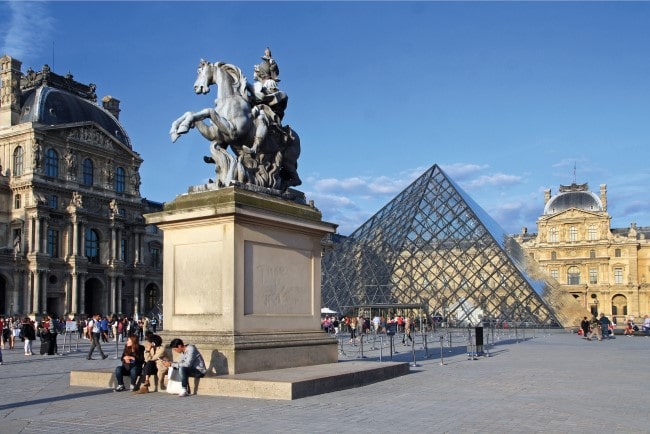
The Louvre © Shutterstock
Upscale dining rooms at the Quai Branly, Musée des Arts Décoratifs and the Grand Palais followed, but none of them topped a certain gastronomic bar until 2015, when Paris’s newly restored 18th-century mint La Monnaie invited three-Michelin star chef Guy Savoy to bring his famous flagship dining room a way up the quay to the new arts centre and Paris ‘destination’. Though the mint’s ambitious plans never fully took off, Savoy’s six beautifully moody dining rooms overlooking the Seine and the Pont Neuf remain a benchmark in great Parisian dining.
Art and ambiance
It’s a big deal when a major new museum opens in any city, but last spring Paris welcomed two, both set in iconic landmark buildings. The Bourse de Commerce–Pinault Collection was inaugurated in May 2021 in Paris’s 19th-century grain and commodities exchange with a gleaming new expanse of interior galleries designed by the Pritzker Prize-winning architect Tadao Ando. The dazzling 18th-century Hôtel de la Marine, at the very heart of Paris on Place de la Concorde, was once a storehouse for the king’s furniture before housing the offices of the French navy for more than 200 years. Both museums arrived with top-notch gastronomic restaurants that are hotspots for foodies and destined to become Paris favourites.

The Bourse de Commerce, one of the most important Paris openings of 2021 © Patric Tourneboeuf
At the Bourse de Commerce, father-and-son-team Michel and Sébastien Bras were given carte blanche in a bid to entice them, at last, outside their native south. Renowned countrywide for their modernist Michelin three-star restaurant Maison Bras, in Laguiole, in the Aveyron countryside, Sébastien Bras confounded the French culinary world in 2017 by handing back his stars, saying he was tired of the gruelling pressure of maintaining them. Two years later, Michelin gave two of them back, reasoning that the restaurant had “refined its concept” and not including it in the guide was “against the rapport and trust” they’d built with the Bras. Sébastien tartly replied, “Michelin has made it clear a restaurant has no choice but to live under pressure.” Now it looks like they’re on their way to shouldering yet another star, thanks to their museum restaurant, no less. The Bras’ elegant, light-drenched restaurant La Halle aux Grains, holds a privileged perch on the Bourse’s glass-domed top floor: on one side overlooking the circular building’s interior 19th-century friezes and rotunda below, and on the other offering eye-level views of the newly scrubbed Saint-Eustace church, the undulating Les Halles canopy and the Centre Pompidou beyond.
With a private entryway and all-afternoon hours, the restaurant offers both an elevated culinary experience at lunch and dinner and an opportunity to take a break from the museum, perhaps with a drink at the bar or a coffee and an exceptional pastry, along with rare eastern-facing views of Paris. Reflecting the Bourse’s original function, each dish is designed to include a grain, whether milled, whole or sprouted. For example, a dish of melt-in-your mouth merlu (hake) comes with a rich crust of buckwheat butter, while succulent venison fillet pairs beautifully with the crisp tang of fresh lentil sprouts. This goes for the sculptural desserts too, all made in-house and meticulously assembled to order.
La Halle aux Grains’ wine list (we are reminded that the grape seed is also a grain) features 30 signature wines specially crafted for the Bras by distinguished producers they’ve developed close relationships with over the years. Each bottle is simply named according to the grape varietal in the bottle, such as a delicately floral Lozet- Muscadelle from Château Palmer in Margaux and a superb Négrette from organic Occitane winemaker Marc Penavayre. Beyond these 30 – which you’ll taste only here – there is a choice list of wines from all French regions.
From Seine to shining sea
It took four years and more than 200 skilled artisans to restore the Hôtel de la Marine, a neoclassical mansion once inhabited by the steward of the king’s furnishings. After feasting your eyes on the museum – a masterpiece of historic interiors unrivalled in Paris – you can feast at one of two sumptuous restaurants: Mimosa, helmed by two-star chef Jean-François Piège, and Lapérouse, the contemporary offshoot of one of Paris’s oldest, most romantic restaurants.
Both dining rooms’ decors and menus have a marine theme. For Mimosa it’s the Mediterranean Sea; for Lapérouse, it’s naval officer and explorer Jean-François de Galaup, comte de Lapérouse, a favourite of King Louis XVI (who, minutes before being beheaded, enquired if La Pérouse had returned from his famous world expedition). Lapérouse’s dignified 18th-century portrait hangs in the hotel’s ballroom. And no, he never returned, but perished alongside his crew. Mimosa’s soaring dining room, housed in the mansion’s old stables, was commandeered by Paris interiors star Dorothée Delaye, who added ribbed ceilings to echo a ship’s hull, dramatic floor-to- ceiling antiqued mirrors, miles of velvet, and mood lighting to create an enticingly cosy-sophisticated ambiance. Ditto at the bar, a gorgeous folie in azure blue. All perfectly refined backdrops for Piège’s Mediterranean-inspired menu of delicacies grilled over a wood fire: octopus with tiny chickpeas and coriander or a magnificent whole grilled catch of the day, in our case with an emulsion of Menton lemon and a luscious fennel fondant. There’s also Brittany lobster with aioli frites and Angus steaks aged on the premises.
Across the courtyard, where both restaurants offer ample outdoor seating, Café Lapérouse – the first offshoot of the quintessentially romantic Paris institution – has been designed by Cordélia de Castellane to echo the nonchalantly chic abode of an eccentric countess, filled with mementoes of exotic places. Diners can breakfast under towering crystal chandeliers or enjoy lunch or dinner in the Salon Orient, overlooking Place de la Concorde.
Sharing dishes on the menu is encouraged, and you’ll want to do that, as it’s impossible to choose between a seasonal menu of gourmet salads and heartier fare, including a succulent lobster roll or the famous langoustine parmentier, a dish that graced the menu of the original Lapérouse in the 1960s when it boasted three Michelin stars and was on the must-go list of every well-heeled traveller.
In warmer weather, the café’s two spacious terraces offer outdoor seating within the mansion’s courtyard (in view of an embedded wave- inspired mosaic of faceted Swarovski crystals that light up like diamonds at night) or a front-row view facing Place de la Concorde.
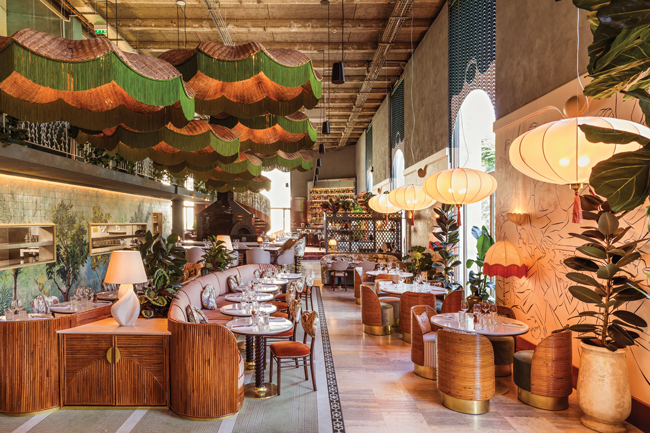
Sink into a velvet chair for a colourful evening at Bambini, the new eatery at the contemporary arts centre Palais de Tokyo ©Romainricard
Notable newcomers
Bambini, the new eatery at the contemporary arts centre Palais de Tokyo, may be at its best in summer, when splendid views of the Eiffel Tower just across the Seine can be had from terraces on both the Art Deco building’s sprawling esplanade and in front on the sidewalk facing the Palais Galliera, Paris’s fashion museum. But in winter, settling into a velvet chair or banquette for a piping hot rigatoni al tartufo, laden with shaved black truffles, or a scrumptious roquette and fior di latte pizza is not to be underestimated. It’s a challenge to work with the giant volumes of this monumental edifice, built for the 1937 International Exhibition, but the new Italian restaurant’s festive interiors confidently evoke La Dolce Vita, with splashes of vivid colour and plenty of vintage accents. Best of all, the restaurant and bar are open until 2am seven days a week, so art lovers and pizza lovers can indulge their hankering for an after-hours meal, a cocktail and a bit of nightlife too.
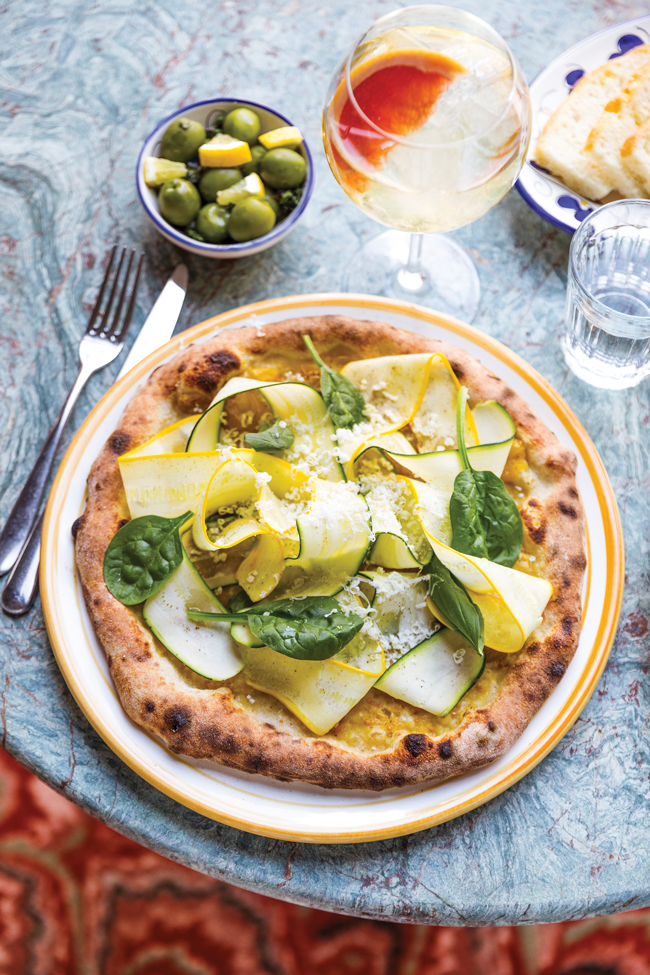
Even the pizza is stylish at Bambini ©Romainricard
Across the esplanade at Forest, the Musée d’Art Moderne de Paris’s new restaurant, diners are treated to a full sensory experience. It starts with a dreamy soundtrack, a kaleidoscope of projections on the walls, a decor evoking a beckoning forest, and a menu of tasty veggie-centric dishes. Exotic pairings, like flambéed oyster mushrooms with pickled rhubarb and parsley oil, crispy duck breast with mustard seeds and sprouts, or beetroot carpaccio with trout caviar, all have a slightly scavenged feel – and that’s a good thing. Desserts are yummy too, but whatever you do don’t miss the trio of chocolate-sea salt cookies, even if you must spirit them home in your handbag for later.
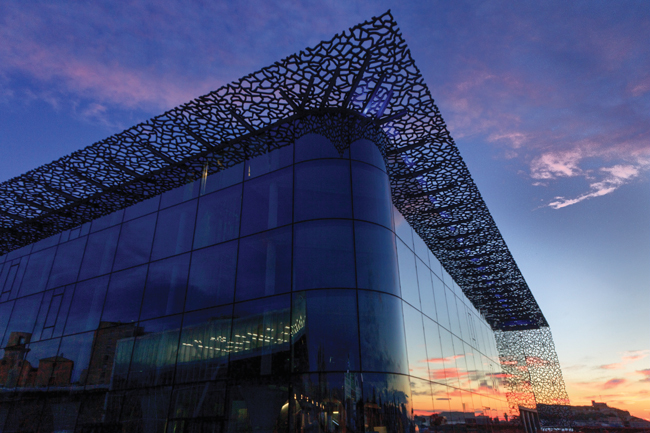
The MuCEM Marseille is home to La Table by Gérald Passedat
Regional Museum Cafés of Note
MUCEM, Marseille / Le Môle Passedat (La Table)
Marseille native Gérald Passedat is best known for his Michelin three-star restaurant and guesthouse Le Petit Nice on Marseille’s coastline. La Table, a chic contemporary space on the top floor of splendid MuCEM Marseille, capitalises on floor-to-ceiling windows to frame endless views of the azure Mediterranean in one of the city’s signature buildings on the J4 Pier. At La Table, Passedat expresses his love for local seasonal produce and the ‘forgotten’ fish of the Mediterranean traditionally used in bouillabaisse, a signature dish (lunch: €55; dinner: €75). www.le-mole-passedat-restaurant-marseille.com
Musée Soulages, Rodez / Café Bras
For a taste of Michel and Sébastien Bras’ magic, head over to this sleek café lodged in one of France’s best small museums. Okay, so maybe Rodez is not on your itinerary, but its location about 40 minutes from the towns of Figeac, Cahors and Albi, and 90 minutes from Toulouse – plus the fact that it’s near some of the loveliest countryside in France – make it well worth a detour. Still undecided? Well, you’re guaranteed to taste some of the best cooking in the country.
www.cafebras.fr/fr
Cité du Vin, Bordeaux / Restaurant Le 7
Besides stellar views of the city and the Garonne River, Le 7 also offers gourmet fare accompanied by a choice of 35 wines by the glass to test your new-found wine knowledge or just to sample the nectars of France’s best-known wine regions.The vibe in this contemporary-elegant dining room is laid back, friendly and welcoming to families and kids.
www.laciteduvin.com/fr/restaurants-boutiques/le-7
Château La Coste, Puy-Sainte-Réparde / Helene Darroze at Villa La Coste
Last July, three-star Michelin chef Hélène Darroze took the helm at the gastronomic restaurant of Château La Coste, a wine estate, luxury lodging and arts centre par excellence in the heart of Provence. It is set on 500 acres of vineyards interspersed with world-class site-specific artworks by the likes of Louise Bourgeois, Andy Goldsworthy, Richard Serra, Ai Weiwei,Tadao Ando and buildings by an eye-popping roster of star architects. One of four restaurants on the premises, this one has marvellous views and, now, a pedigree. www.villalacoste.com/en/dining-in-provence
Hôtel de Caumont, Aix-en-Provence / Café Caumont
Though far less grand than the gastronomic restaurants listed above, Café Caumont, set in a beautifully restored old mansion, home of the superb Culturespaces arts centre, offers a lovely setting, a garden terrace and satisfying fare in one of Provence’s top museums.Teatime in the garden is a treat and the pastries are always spot on.
From France Today magazine
Lead photo credit : Café Lapérouse offers exceptional cuisine courtesy of Café Lapérouse
Share to: Facebook Twitter LinkedIn Email
More in Haute cuisine, Museum Restaurants, museums, Paris museums
Leave a reply
Your email address will not be published. Required fields are marked *





